Written by: YQ
Translated by: Tia, Techub News
The on-chain payment revolution has arrived, and it is massive. Visa's analytics dashboard shows that the **actual transaction volume on public blockchains has reached $10 trillion, with *2 billion transactions* processing $216.5 billion in stablecoin supply. Google has just launched the Agent2Agent protocol and partnered with over 50 corporate partners, including PayPal, Salesforce, and SAP, designed specifically for autonomous AI agents to "pay and receive service fees." The infrastructure is ready, institutional capital is in place, and demand is exploding. Coinbase's x402 protocol provides the foundational specifications for HTTP 402 payments on the blockchain, establishing EIP-3009 integration, facilitator models, and HTTP header conventions, enabling machine-native micropayments. This specification work is crucial, but specifications alone cannot drive large-scale production systems.
x402x has emerged in this context as a necessary complement to x402. x402 defines the protocol specifications, while x402x provides the production-ready implementation layer required for large-scale enterprise deployment. As AI systems gradually evolve into autonomous economic agents capable of trading data, purchasing API access, and coordinating multi-agent workflows, they require both a solid protocol foundation (x402) and a battle-tested scalability (x402x). The x402 specification and x402x implementation together build a complete technology stack for the agent economy. x402x expands x402 with five key features, transforming the specification into deployable infrastructure: achieving economic sustainability through platform fees, ensuring reliability through atomic settlement, enabling scalability through hooks, improving efficiency through batch processing, and supporting multiple tokens to cover the entire ecosystem.
Why does x402 need expansion?
Coinbase's x402 protocol represents significant progress in solving a problem that has persisted for thirty years. The specification establishes HTTP 402 as a payment signaling mechanism, integrates EIP-3009 for gasless transfers, defines the coordinator role for settlement coordination, and creates standard HTTP headers for payment metadata. This foundational work enables developers to implement HTTP 402 payments on EVM blockchains through standardized interfaces. The specification has gained widespread attention due to Coinbase's institutional support, integration potential with Google's A2A protocol, and the growing developer ecosystem. However, like any protocol specification, x402 needs implementable solutions that can address real operational issues for production environments, such as economic sustainability models, performance optimization strategies, security hardening measures, scalability frameworks, and practical deployment patterns. This is not a criticism of x402. All successful protocols require an implementation layer that complements the specification.
Five Extensions Added to x402
x402x expands the x402 specification in five key areas, equipping it with production-ready capabilities. These extensions enhance the protocol design of x402 while maintaining full compatibility with the specification. Enterprises can deploy x402x as the implementation layer for x402-based applications, thereby benefiting from both the standardized protocol of x402 and the production environment optimizations of x402x.
Extension 1: Economic Sustainability Layer
x402x adds a configurable and optional platform fee mechanism (more like a merchant fee) on top of the x402 specification. x402 defines the payment process, while x402x expands on this to create sustainable economic benefits: in the case of 1 million transactions, payment service providers can earn $8,100 in profit per month instead of losing $2,100, thereby creating a viable business model for infrastructure operators at scale.
Extension 2: Atomic Settlement Architecture
x402x provides a direct contract settlement option based on the intermediary model of x402. The gateway contract atomically executes verification, authorization, transfer, fee deduction, and nonce marking in a single transaction. This reduces the delay from x402's 500-1100 milliseconds two-phase process to 200-500 milliseconds of atomic settlement while maintaining full compatibility with the x402 specification.
Extension 3: Scalability through Hooks
x402x adds a four-hook system to the payment process of x402: beforePayment, afterPayment, beforeBatchPayment, and afterBatchPayment. Merchants can inject custom TypeScript code for credential verification, subscription checks, NFT minting, loyalty rewards, and complex settlement logic. This extends the fixed processes of x402 while retaining the core protocol, enabling application-specific custom functionalities.
Extension 4: Batch Processing Optimization
x402x extends x402 with batch settlement capabilities, allowing up to 100 payments to be aggregated in a single transaction. This optimization reduces the gas cost per payment from $0.00070 to $0.000055 (a 92% savings) while maintaining independent event outputs for each transaction. The BatchProcessor service is responsible for queuing payments and automatically settling every 2 seconds.
Extension 5: Multi-Token Architecture
x402x adds a roadmap for supporting EIP-2612 (DAI) and base ERC-20 (USDT) on top of x402's support for EIP-3009. The modular token interface allows the Gateway contract to support multiple authorization modes, expanding the coverage of the x402 ecosystem from the current 13% ($25 billion USDC) to 100% of the $187 billion stablecoin market.
How x402x Complements the x402 Architecture
x402x is built directly on the x402 specification rather than replacing it. The gateway contract accepts the same EIP-3009 signatures as x402 service providers, retains the HTTP 402 response codes and X-PAYMENT headers defined in the specification, supports the payment details metadata format of x402, and uses ecrecover signature verification to maintain x402's security model. Developers familiar with x402 can integrate x402x with minimal code changes. The core difference lies in the deployment model: x402 specifies the coordination mechanism for service providers, while x402x provides a direct contract implementation that can operate independently of service providers. This flexibility means that x402x can serve as a plug-and-play enhancement for existing x402 integrations or as an independent implementation of the x402 protocol.
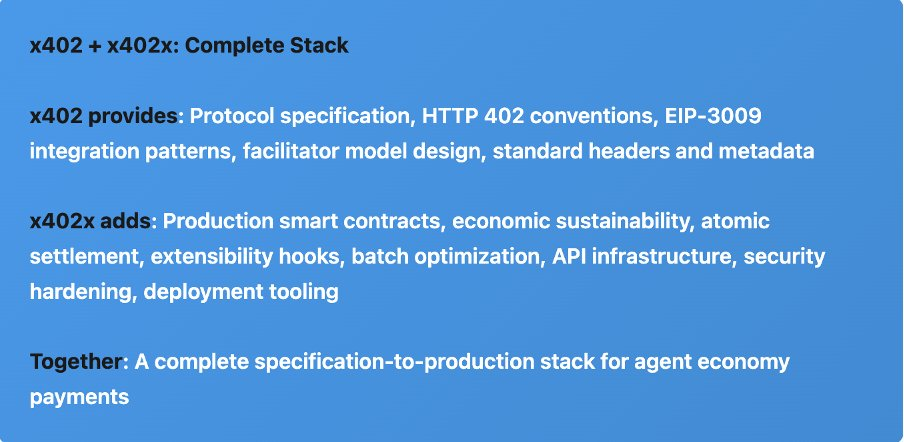
Architecture: x402 Specification and x402x Implementation
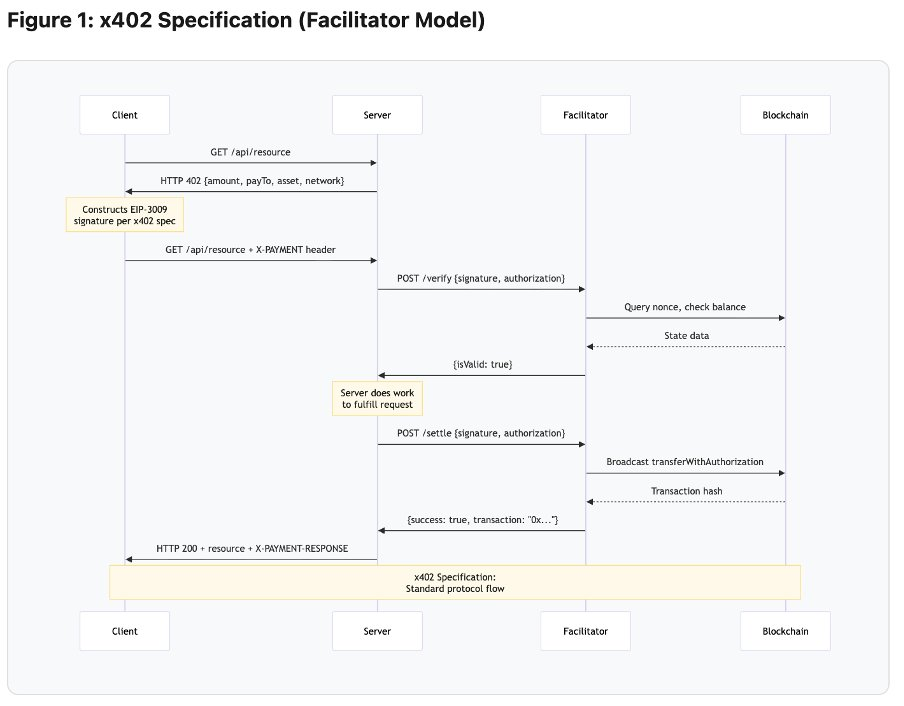
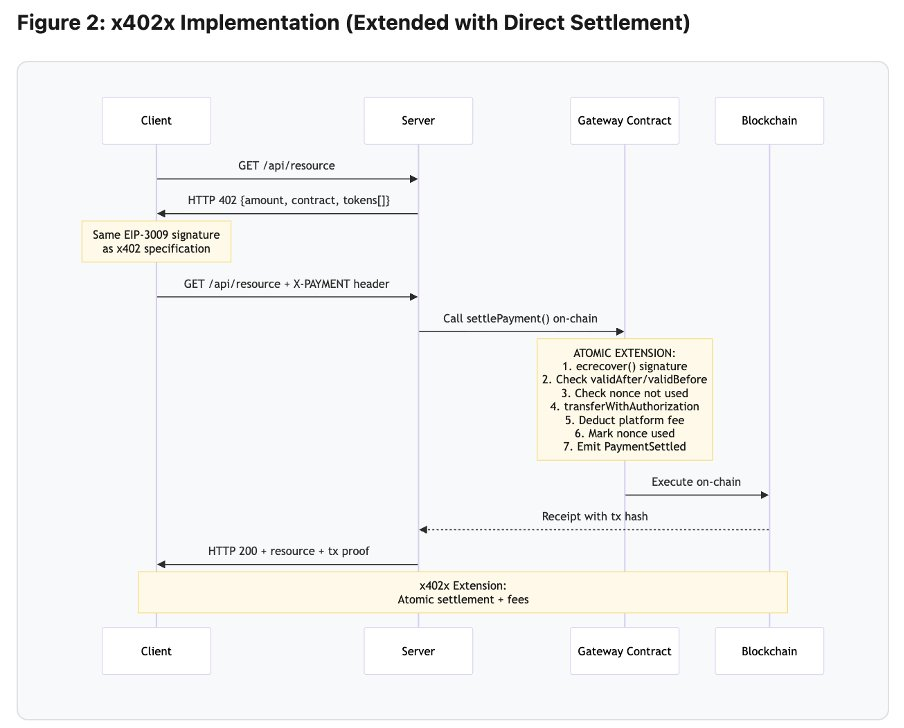
The key point is that x402x uses the same EIP-3009 signatures and HTTP headers as x402. Its extension lies in the architecture: x402x no longer coordinates settlements through intermediaries but provides a smart contract to atomically execute the entire process. Both methods implement the x402 protocol. x402x simply offers an optimized implementation path and adds production environment capabilities. Developers can choose between the intermediary-based x402 (more flexible but requires infrastructure), the direct contract x402x (more atomic and self-contained), or a hybrid solution that combines both models based on specific use case needs.
Extension Plan 1: Achieving Economic Sustainability through Platform Fees (Optional)
x402x adds a configurable platform fee mechanism on top of x402, making infrastructure operations financially sustainable. The gateway contract automatically deducts a fee of 0-5% at settlement, enforcing a maximum cap of 5% to prevent excessive extraction, while publishing on-chain events to enhance transparency and allowing fee updates controlled by governance mechanisms. This extension transforms zero-fee payment service providers into profitable infrastructure operators by charging merchant fees. The default fee is 1%, which is 66% lower than Stripe's (2.9%), while still generating sufficient revenue for engineering, security, compliance, and ongoing development.

For reference: Visa reports that the adjusted on-chain transaction volume is $10 trillion, and a 1% protocol fee could generate $100 billion in revenue for the infrastructure layer annually. Even capturing just 0.1% of that market share ($10 billion in transaction volume) could create $100 million in sustainable funding for the development of x402x and benefit the entire x402 ecosystem by providing verified implementation references.
Extension Plan 2: Batch Processing Can Reduce Costs by 92%
x402x expands the functionality of x402 by adding batch settlement capabilities, significantly reducing the cost per transaction. The executeBatchRequest() function can aggregate up to 100 payments into a single transaction, spreading fixed costs (signature verification, contract initialization, event emission) across multiple settlements. The server-side BatchProcessor service automatically queues payments and settles every 2 seconds. For merchants processing 100,000 payments monthly, this extension can reduce costs from $70 to $5.50 while still maintaining separate event emissions for each payment.
Batch Processing Extension - Gas Savings Analysis
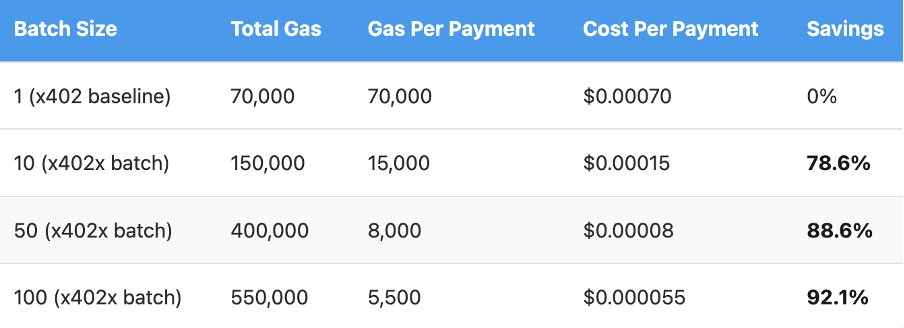
Extension 3: Scalability through Hooks
x402x adds four custom hooks to the fixed payment process of x402: beforePayment, afterPayment, beforeBatchPayment, and afterBatchPayment. Merchants can inject TypeScript functions containing the complete payment context (sender, amount, token, timestamp, metadata). The before hook can roll back transactions to enforce business logic. The after hook is non-reversible since the payment has been settled on-chain. This extension allows for application-specific logic (such as credential checks, subscription validation, NFT minting, membership programs, etc.) without modifying the core x402 protocol.
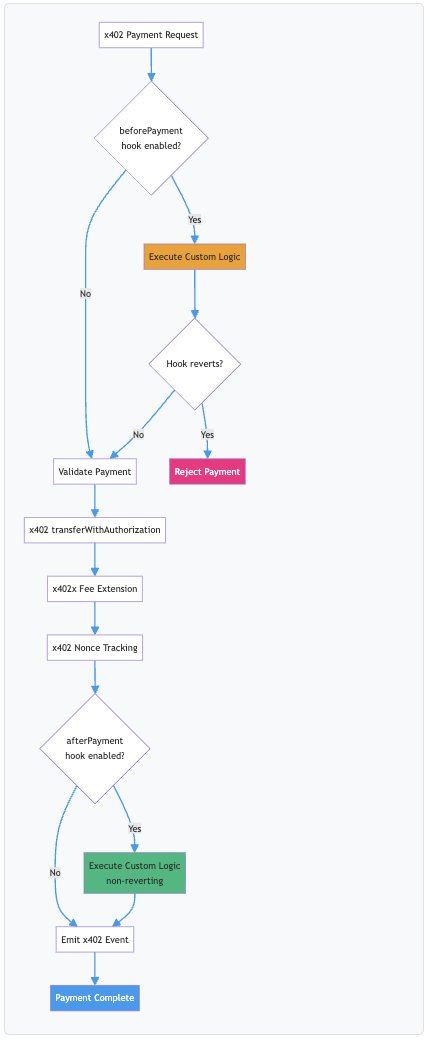
Hook Extension Use Cases
Before Payment: Validate credentials, check subscription status, enforce spending limits, verify KYC/AML (can block payment).
After Payment: Generate NFT receipts, reward loyalty points, provide API access, trigger webhooks (non-blocking).
Before Batch Payment: Validate batch composition, enforce size limits, check total amount.
After Batch Payment: Reconcile multi-party settlements, update analytics, generate batch reports.
Why x402x Should Be Natively Integrated into x402
x402x demonstrates a mature model that can be applied as a native feature in x402. The configurable fee mechanism provides a validated economic model for the protocol's sustainability. Atomic settlement offers an alternative to intermediary coordination with lower latency and simplified infrastructure. The hook system supports application-specific extensions without modifying the protocol. Batch processing significantly reduces costs for large-scale applications. The multi-token architecture expands the ecosystem's coverage. These extensions meet the operational demands faced by enterprises during deployment while maintaining full compatibility with x402. By natively integrating the x402x model into x402, Coinbase can provide both the specification and reference implementation in a single package, accelerating the adoption of x402 and reducing integration complexity for developers.

Agent Economy Use Cases: Why Both x402 and x402x Are Important
AI agents need to pay service fees at machine speed and scale. An autonomous research assistant querying academic databases, patent archives, and news APIs may need to execute 35 payments per task. A trading bot monitoring exchange dynamics can process 30 payments per second. A multi-tool interface similar to ChatGPT can pay for weather data, flight searches, and price histories in a single conversation. These use cases require both the protocol specification (x402) and the extensions (x402x). The specification ensures interoperability between different implementations, while the infrastructure ensures reliable large-scale operation. Together, they enable the agent economy to operate with the same maturity of payment infrastructure as traditional internet commerce did decades ago.
Agent Payment Scenarios - x402 Specification + x402x Implementation
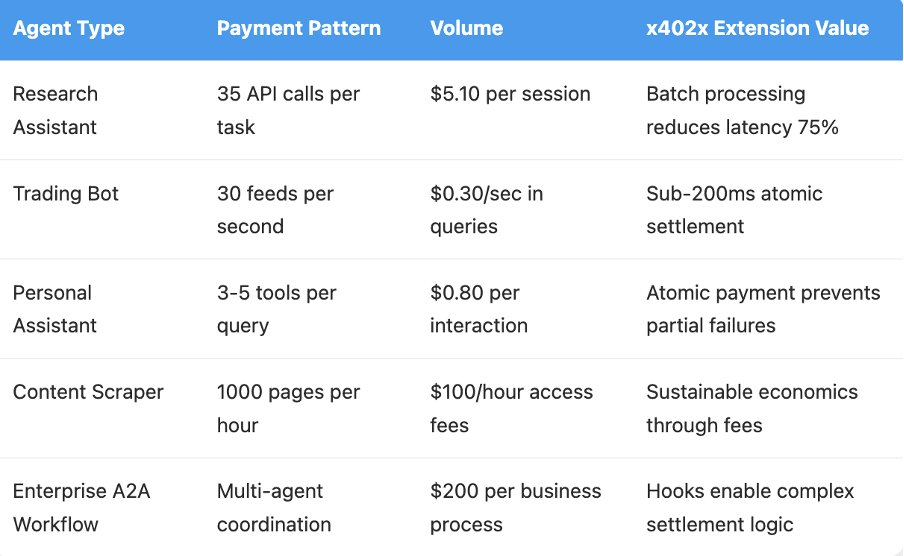
x402x as an Extension of x402
The x402 protocol represents significant progress in solving a problem that has persisted for thirty years. Coinbase's specification work establishes a standardized HTTP 402 model, EIP-3009 integration agreements, coordinator coordination models, and header formats for interoperability. This foundational specification is crucial for the development of the ecosystem. However, the protocol needs a reference implementation that can demonstrate production patterns. x402x provides the extensions for this implementation layer to achieve economic sustainability, atomic settlement, batch optimization, scalable interfaces, and multi-token support. The ideal outcome is to achieve native integration: to have the x402 specification and x402x model as the official reference implementation. This would create a complete package, allowing developers to obtain both the protocol standard and verified infrastructure with a single integration.
A $10 trillion on-chain payment market truly exists. 2 billion transactions truly exist. The A2A protocol developed by Google in collaboration with over 50 corporate partners truly exists. The demand for payment infrastructure in the agent economy is real. x402 provides the standardized protocol specifications for implementation. x402x provides the extensions for deployment. Together, they build the complete technology stack needed for the agent economy. The autonomous internet requires autonomous payments. Not tomorrow, not after more research, but today, through running code, real transactions, and production deployments.
免责声明:本文章仅代表作者个人观点,不代表本平台的立场和观点。本文章仅供信息分享,不构成对任何人的任何投资建议。用户与作者之间的任何争议,与本平台无关。如网页中刊载的文章或图片涉及侵权,请提供相关的权利证明和身份证明发送邮件到support@aicoin.com,本平台相关工作人员将会进行核查。




